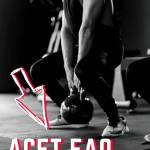The Army Combat Fitness Test (ACFT) has introduced a series of physical tasks designed to assess the physical readiness of soldiers. One of the key exercises in this test is the deadlift, a fundamental strength movement that challenges the lower body, core, and grip. However, executing a deadlift with proper technique is essential for maximizing performance and preventing injury. This guide will walk you through the proper ACFT deadlift technique, offering helpful tips and considerations to ensure you succeed on test day.
What is the ACFT Deadlift?
The ACFT deadlift is a strength test that measures an individual’s ability to lift a hexagonal barbell from the floor. This exercise mimics real-world situations where soldiers may need to lift heavy objects in various scenarios. It targets major muscle groups, including the glutes, hamstrings, quads, lower back, and core.
In the ACFT, the hex bar deadlift is used, which is a safer variation of the traditional barbell deadlift. The hex bar design allows the lifter to step inside the bar, offering a more neutral grip and reducing strain on the lower back.
Key Benefits of Proper ACFT Deadlift Technique
- Improved Performance: Correct form helps you lift heavier weights.
- Prevents Injury: Proper technique ensures your muscles and joints are not overstressed.
- Increases Strength: The deadlift is a powerful movement for building overall body strength.
Step-by-Step Guide to ACFT Deadlift Technique
1. Set Your Stance
The first step in perfecting your deadlift technique is to establish the right stance.
- Feet Position: Position your feet about shoulder-width apart. Your toes should point straight or slightly outward.
- Bar Placement: The hex bar should be in line with the middle of your feet, not too far forward or backward.
- Grip: Grab the handles of the hex bar with both hands. Your arms should be fully extended, and your hands should be at a comfortable distance from your body.
2. Check Your Back and Posture
Maintaining a neutral spine is crucial for a safe lift.
- Hips and Back: Bend at your hips and knees simultaneously to lower your body toward the bar. Your back should stay straight throughout the movement, not rounded or arched.
- Chest Up: Keep your chest lifted and your shoulders back. This will naturally align your spine and help avoid injury.
3. Engage Your Core and Prepare to Lift
Before lifting the weight, engage your core muscles.
- Core Activation: Tighten your core by pulling your belly button toward your spine. This will help support your lower back during the lift.
- Breathing: Take a deep breath and hold it as you prepare to lift. This creates intra-abdominal pressure that stabilizes your body.
4. Lift the Weight
Now that you’ve set your stance and engaged your core, it’s time to lift the weight.
- Push Through the Heels: Begin the lift by driving through your heels, not your toes. Your legs should be the primary movers, followed by your hips and lower back.
- Stand Tall: As you lift, extend your hips and knees at the same time. Your torso should rise with the bar, and your back should remain neutral.
- Lockout: Once the bar reaches the top, stand tall with your shoulders back and chest forward. Do not lean backward or overextend your lower back.
5. Lower the Weight
After reaching the standing position, it’s time to lower the bar back to the ground.
- Hips First: Push your hips back first, then bend your knees to lower the bar safely to the ground.
- Controlled Descent: Keep the movement slow and controlled. Avoid dropping the weight, as this can lead to injury.
Common Mistakes to Avoid
While the ACFT deadlift may seem straightforward, there are some common mistakes that can negatively impact your performance and safety:
1. Rounded Back
A rounded back increases the risk of injury, especially to the spine. Always aim for a neutral spine position throughout the movement.
2. Using the Arms to Pull the Weight
The deadlift is primarily a lower-body movement. If you rely too much on your arms to pull the weight, you risk straining your back.
3. Jerking the Weight
Trying to jerk the weight off the ground too quickly can lead to loss of control. Focus on a smooth and controlled lift, especially at the beginning.
4. Overextending at the Top
Avoid leaning back or arching your lower back at the top of the lift. Standing tall with your shoulders back is the correct finishing position.
ACFT Deadlift Training Tips
To perform your best on the ACFT, consistent training is key. Here are a few tips to help improve your deadlift performance:
1. Focus on Mobility
Flexibility in the hips, hamstrings, and lower back will help you maintain proper form. Incorporate stretches and dynamic warm-ups into your routine to improve range of motion.
2. Gradually Increase Weight
Start with lighter weights to master the workout before progressing to heavier loads. Gradually increase the weight as you become more confident in your form.
3. Strengthen Your Core
A strong core is essential for a safe and effective deadlift. Include core exercises, such as planks and leg raises, in your training routine to improve stability.
4. Practice Consistently
Like any skill, deadlifting improves with practice. Consistently practice the movement to build muscle memory and reinforce correct form.
Conclusion
Mastering the ACFT deadlift technique is essential for performing well on the Army Combat Fitness Test. By focusing on proper posture, breathing, and lifting mechanics, you can not only improve your deadlift score but also avoid injury. Remember, gradual practice, proper technique, and strength training are the keys to success. Whether you’re preparing for the ACFT or looking to enhance your overall fitness, perfecting the deadlift is a great way to build strength and power. Keep training smart and safe, and you’ll be ready to crush your ACFT deadlift!
Check Our Most Up to date ACFT Calculator Now!










